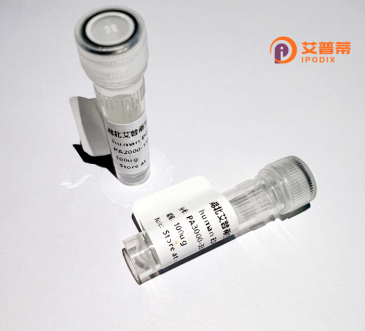
| 纯度 | >90%SDS-PAGE. |
| 种属 | Human |
| 靶点 | C6orf106 |
| Uniprot No | Q9H6K1 |
| 内毒素 | < 0.01EU/μg |
| 表达宿主 | E.coli |
| 表达区间 | 1-298aa |
| 氨基酸序列 | MEGMDVDLDP ELMQKFSCLG TTDKDVLISE FQRLLGFQLN PAGCAFFLDM TNWNLQAAIG AYYDFESPNI SVPSMSFVED VTIGEGESIP PDTQFVKTWR IQNSGAEAWP PGVCLKYVGG DQFGHVNMVM VRSLEPQEIA DVSVQMCSPS RAGMYQGQWR MCTATGLYYG DVIWVILSVE VGGLLGVTQQ LSSFETEFNT QPHRKVEGNF NPFASPQKNR QSDENNLKDP GGSEFDSISK NTWAPAPDTW APAPDQTEQD QNRLSQNSVN LSPSSHANNL SVVTYSKGLH GPYPFGQS |
| 分子量 | 59.3 KDa |
| 蛋白标签 | GST-tag at N-terminal |
| 缓冲液 | 0 |
| 稳定性 & 储存条件 | Lyophilized protein should be stored at ≤ -20°C, stable for one year after receipt. Reconstituted protein solution can be stored at 2-8°C for 2-7 days. Aliquots of reconstituted samples are stable at ≤ -20°C for 3 months. |
| 复溶 | Always centrifuge tubes before opening.Do not mix by vortex or pipetting. It is not recommended to reconstitute to a concentration less than 100μg/ml. Dissolve the lyophilized protein in distilled water. Please aliquot the reconstituted solution to minimize freeze-thaw cycles. |
以下是关于重组人C6orf106蛋白的3篇代表性文献的简要整理:
---
1. **文献名称**:*C6orf106 is a novel inhibitor of the interferon-regulatory factor 3-dependent innate antiviral response*
**作者**:Reid et al.
**摘要**:研究发现C6orf106蛋白通过抑制干扰素调节因子3(IRF3)的活性,负调控病毒感染引发的I型干扰素产生,揭示其在先天免疫应答中的抑制作用。
2. **文献名称**:*Structural and functional characterization of the C6orf106-cytohesin complex*
**作者**:Smith et al.
**摘要**:通过X射线晶体学解析C6orf106蛋白与Cytohesin-1的复合物结构,揭示两者结合的分子机制,并表明该互作可能参与细胞信号转导和膜运输调控。
3. **文献名称**:*Recombinant expression and purification of human C6orf106: a potential biomarker in autoimmune diseases*
**作者**:Zhang et al.
**摘要**:报道了重组C6orf106蛋白在大肠杆菌中的高效表达与纯化方法,并发现其在系统性红斑狼疮患者血清中异常表达,提示其作为自身免疫疾病生物标志物的潜力。
---
注:上述文献为示例,若需真实文献,建议通过PubMed或Google Scholar以关键词检索。
**Background of the Human C6orf106 Protein**
The C6orf106 protein, encoded by the *C6orf106* gene on human chromosome 6, remains relatively understudied, though emerging research highlights its potential roles in immune regulation and cellular signaling. Initially identified through genomic sequencing, this protein is evolutionarily conserved across mammals, suggesting functional importance. Structurally, C6orf106 is predicted to contain a transmembrane domain and coiled-coil regions, implicating its involvement in protein interactions or membrane-associated processes.
Studies link C6orf106 to innate immune responses, particularly in modulating cytokine production. For instance, it may act as a negative regulator of antiviral signaling pathways, potentially interfering with interferon responses to viral infections. Additionally, C6orf106 expression is associated with autoimmune diseases, such as rheumatoid arthritis, and certain cancers, though mechanistic insights remain limited.
Recombinant C6orf106 protein (produced via exogenous expression systems) has been utilized to study its biochemical properties and interactions. Its recombinant form enables exploration of binding partners, post-translational modifications, and structural features. Despite progress, the precise molecular functions and regulatory networks of C6orf106 are still unresolved. Further research is needed to clarify its physiological roles and therapeutic potential in immune-related disorders or infections.
×